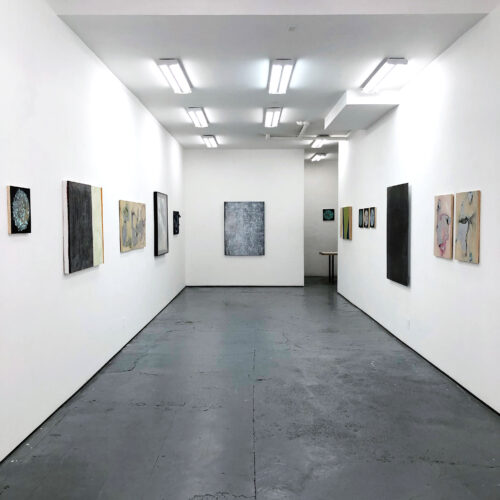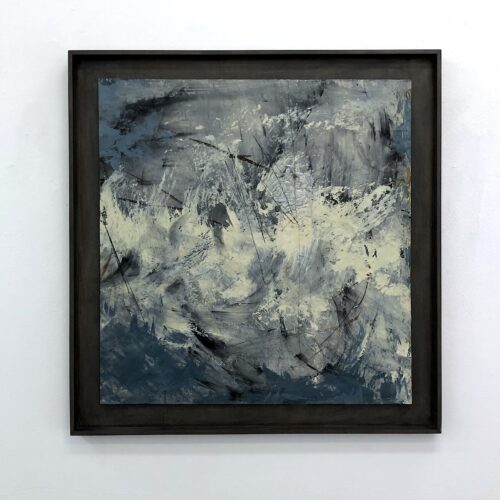The six artists whose works are currently found at Lichtundfire, the Lower East Side gallery, all deal with the sidereal dissonance produced by the clashing of galaxies. Their art consists of visual noise that may or may not be coherent or free-form. Capturing celestial events in the universe is more difficult than it seems from an artistic point of view. How do we visually stage a theater in which we can meditate on the heavenly conflicts that occur, often invisible to the naked eye. The scenes we come across in this show do not necessarily indicate a scientific outlook; rather, they portray conflicting atmospheric occurrences in ways that lean toward a poetic understanding of the universe. As a result, these paintings can be viewed as both a report on scientific phenomena and a reading of the distant skies.
Curator Priska Juschka has done a very good job of putting together a muted viewing of the artists’ approach to disturbances in the skies, far away from Earth. Sometimes the imagery is recognizable, and sometimes it looks very abstract. One thinks of planets, dark matter, light radiating through space. The six artists produce works that actually tie in with each other stylistically more closely than one would think. Deep, muted tonalities abound. In Leslie Ford’s Ball of Confusion #13 (2022), we see a sphere poised against a black atmosphere. The sphere is covered with light blue fragments whose edges are jagged; beneath them are what look like skeins of brown rope. As the image’s title declares, the air of confusion on this planet is paramount. Ford offers us a well-known form, abstractly embellished in the middle of the dark. This kind of image, known and unknown to us, makes it clear that even pictures stereotypical in regard to space imagery can be made interesting and compelling.
Jim Napierala’s triptych, named Ababiel, Hodniel, Kabiniel: The Angels That Can Cure Stupidity (2021), consists of enamel and watercolor on wood panel. There is a brown background for each of the three panels, which serve as the visual support for the complicated gray, organically abstract forms that present rounded edges and broken fragments. The imagery in the three panels may not reflect the collision of heavenly systems, but the title guides us to angelic presences, said to cure the propensity for human dumbness. How does one draw such an angel? Inevitably, one works within abstraction, as the depiction of angels remains entirely within the sphere of the imagination. We can appreciate the work, though, as a highly accomplished abstraction, whose gray-tone emanations suggest presences beyond our reach yet affecting us. Augustus Goertz’s Rough Universe II (2022) is composed of swirling swathes of luminous blue and black, with a flower-like protrusion from its surface on the upper right. The twisting expanse of blue, with what appears like lightning on the left, hovers above a darker, straighter stripe, variously embellished. All in all, Goertz, an excellent painter of rough abstraction, gives us a free fall across a tumbling cosmos. Not only are the patterns of large collections of stars emphasized, the movement of galaxies are dramatically suggested.
Philip Gerstein’s abstraction, The Wind Carries the Scent (2018), has a thin black stripe on the far left and a thin orange stripe on the far right. Next to the black stripe is a squared expanse of purple-black, lightened to a degree by white beneath striations of purple and black. To its right, next to the orange stripe, is a narrower expanse of textured white with embedded glass beads. How does a painter depict the wind carrying scent? By the very nature of the description, it is impossible to see. So, instead, Gerstein gives us a highly sophisticated painting, which may, or may not, embody the invisible image as described by the title. Arlene Santana Thornton’s Particles of Light (2021) is straightforwardly a depiction of small luminous particles against a gray background; they are so dense as to form nearly a mist, with a transparent haze of white occurring on the left half of the work. At once an abstraction and a visionary treatment of light and perhaps a thicket of stars, Particles of Light reminds us that art can be both figurative and nonobjective in the same moment. The poetry of the skies, near and far from earth, demonstrates to us that the natural generates most of our visual and literary metaphors. Here Santana Thornton does an excellent job of recording their lyricism.
Bobbie Moline-Kramer’s charged work, called Fury (2016), made with colored gesso, oil, and thread on paper, consists of expressionistically painted, dense waves of white in the center, along with grays, equally free in execution, above and below the middle passage of white. It is indeed a furious painting, made more so by the way it is worked and the considerable contrast between the tones of white and gray and black. This is a work that relates both to lyric abstraction and to the fervent depiction of emotion. It also might be a dramatic reading of a turbulent sky with clouds. All in all, the works in “Cosmic Storm” reach for a platform that is half art, half observatory. Densities of matter come together and fall apart—an action that paint describes well. Juschka, a particularly good curator of dampened abstraction, has found a group of works that can be read that way, even if they describe conflict within the cosmos. The densities of tone we experience in these paintings remind us that the representation of the storm, earthly or cosmic, carries its own drama. “Cosmic Storm” indicates this very well in its offerings.
Jonathan Goodman, March 2022
LICHTUNDFIRE, 175 Rivington Street, New York, NY 10002, 347-977-5541
Tues – Sat, 12 – 6 pm; and by appointment
www.lichtundfire.com


